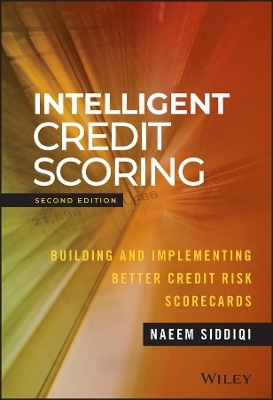
Intelligent Credit Scoring
John Wiley & Sons Inc (Verlag)
978-1-119-27915-0 (ISBN)
A better development and implementation framework for credit risk scorecards Intelligent Credit Scoring presents a business-oriented process for the development and implementation of risk prediction scorecards. The credit scorecard is a powerful tool for measuring the risk of individual borrowers, gauging overall risk exposure and developing analytically driven, risk-adjusted strategies for existing customers. In the past 10 years, hundreds of banks worldwide have brought the process of developing credit scoring models in-house, while ‘credit scores' have become a frequent topic of conversation in many countries where bureau scores are used broadly. In the United States, the ‘FICO' and ‘Vantage' scores continue to be discussed by borrowers hoping to get a better deal from the banks. While knowledge of the statistical processes around building credit scorecards is common, the business context and intelligence that allows you to build better, more robust, and ultimately more intelligent, scorecards is not. As the follow-up to Credit Risk Scorecards, this updated second edition includes new detailed examples, new real-world stories, new diagrams, deeper discussion on topics including WOE curves, the latest trends that expand scorecard functionality and new in-depth analyses in every chapter. Expanded coverage includes new chapters on defining infrastructure for in-house credit scoring, validation, governance, and Big Data.
Black box scorecard development by isolated teams has resulted in statistically valid, but operationally unacceptable models at times. This book shows you how various personas in a financial institution can work together to create more intelligent scorecards, to avoid disasters, and facilitate better decision making. Key items discussed include:
Following a clear step by step framework for development, implementation, and beyond
Lots of real life tips and hints on how to detect and fix data issues
How to realise bigger ROI from credit scoring using internal resources
Explore new trends and advances to get more out of the scorecard
Credit scoring is now a very common tool used by banks, Telcos, and others around the world for loan origination, decisioning, credit limit management, collections management, cross selling, and many other decisions. Intelligent Credit Scoring helps you organise resources, streamline processes, and build more intelligent scorecards that will help achieve better results.
NAEEM SIDDIQI is the Director of Credit Scoring and Decisioning with SAS® Institute. He has more than twenty years of experience in credit risk management, both as a consultant and as a user at financial institutions. He played a key role in developing SAS® Credit Scoring and continues to provide worldwide support for the initiative.
Acknowledgments xiii Chapter 1 Introduction 1
Scorecards: General Overview 9
Notes 18
Chapter 2 Scorecard Development: The People and the Process 19
Scorecard Development Roles 21
Intelligent Scorecard Development 31
Scorecard Development and Implementation Process: Overview 31
Notes 34
Chapter 3 Designing the Infrastructure for Scorecard Development 35
Data Gathering and Organization 39
Creation of Modeling Data Sets 41
Data Mining/Scorecard Development 41
Validation/Backtesting 43
Model Implementation 43
Reporting and Analytics 44
Note 44
Chapter 4 Scorecard Development Process, Stage 1: Preliminaries and Planning 45
Create Business Plan 46
Create Project Plan 57
Why “Scorecard” Format? 60
Notes 61
Chapter 5 Managing the Risks of In-House Scorecard Development 63
Human Resource Risk 65
Technology and Knowledge Stagnation Risk 68
Chapter 6 Scorecard Development Process, Stage 2: Data Review and Project Parameters 73
Data Availability and Quality Review 74
Data Gathering for Definition of Project Parameters 77
Defi nition of Project Parameters 78
Segmentation 103
Methodology 116
Review of Implementation Plan 117
Notes 118
Chapter 7 Default Definition under Basel 119
Introduction 120
Default Event 121
Prediction Horizon and Default Rate 124
Validation of Default Rate and Recalibration 126
Application Scoring and Basel II 128
Summary 129
Notes 130
Chapter 8 Scorecard Development Process, Stage 3: Development Database Creation 131
Development Sample Specification 132
Sampling 140
Development Data Collection and Construction 142
Adjusting for Prior Probabilities 144
Notes 148
Chapter 9 Big Data: Emerging Technology for Today’s Credit Analyst 149
The Four V’s of Big Data for Credit Scoring 150
Credit Scoring and the Data Collection Process 158
Credit Scoring in the Era of Big Data 159
Ethical Considerations of Credit Scoring in the Era of Big Data 164
Conclusion 170
Notes 171
Chapter 10 Scorecard Development Process, Stage 4: Scorecard Development 173
Explore Data 175
Missing Values and Outliers 175
Correlation 178
Initial Characteristic Analysis 179
Preliminary Scorecard 200
Reject Inference 215
Final Scorecard Production 236
Choosing a Scorecard 246
Validation 258
Notes 262
Chapter 11 Scorecard Development Process, Stage 5: Scorecard Management Reports 265
Gains Table 267
Characteristic Reports 273
Chapter 12 Scorecard Development Process, Stage 6: Scorecard Implementation 275
Pre-implementation Validation 276
Strategy Development 291
Notes 318
Chapter 13 Validating Generic Vendor Scorecards 319
Introduction 320
Vendor Management Considerations 323
Vendor Model Purpose 326
Model Estimation Methodology 331
Validation Assessment 337
Vendor Model Implementation and Deployment 340
Considerations for Ongoing Monitoring 341
Ongoing Quality Assurance of the Vendor 351
Get Involved 352
Appendix: Key Considerations for Vendor Scorecard Validations 353
Notes 355
Chapter 14 Scorecard Development Process, Stage 7: Post-implementation 359
Scorecard and Portfolio Monitoring Reports 360
Reacting to Changes 377
Review 399
Notes 401
Appendix A: Common Variables Used in Credit Scoring 403
Appendix B: End-to-End Example of Scorecard Creation 411
Bibliography 417
About the Author 425
About the Contributing Authors 427
Index 429
| Erscheinungsdatum | 26.01.2017 |
|---|---|
| Reihe/Serie | SAS Institute Inc |
| Verlagsort | New York |
| Sprache | englisch |
| Maße | 160 x 231 mm |
| Gewicht | 680 g |
| Themenwelt | Betriebswirtschaft / Management ► Spezielle Betriebswirtschaftslehre ► Bankbetriebslehre |
| ISBN-10 | 1-119-27915-1 / 1119279151 |
| ISBN-13 | 978-1-119-27915-0 / 9781119279150 |
| Zustand | Neuware |
| Haben Sie eine Frage zum Produkt? |
aus dem Bereich


